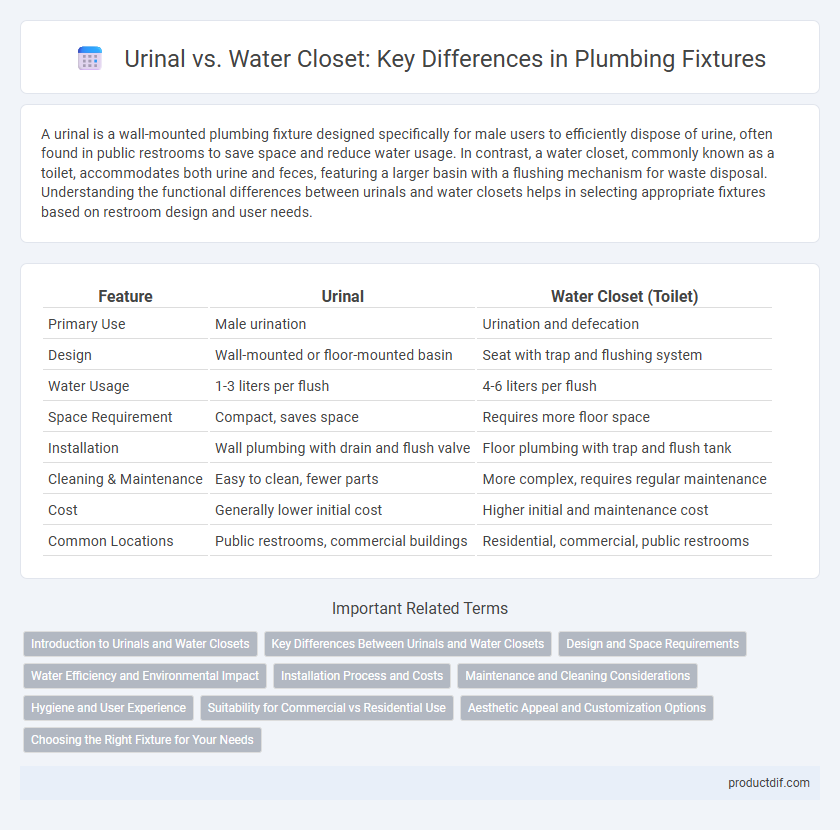A urinal is a wall-mounted plumbing fixture designed specifically for male users to efficiently dispose of urine, often found in public restrooms to save space and reduce water usage. In contrast, a water closet, commonly known as a toilet, accommodates both urine and feces, featuring a larger basin with a flushing mechanism for waste disposal. Understanding the functional differences between urinals and water closets helps in selecting appropriate fixtures based on restroom design and user needs.
Table of Comparison
| Feature | Urinal | Water Closet (Toilet) |
|---|---|---|
| Primary Use | Male urination | Urination and defecation |
| Design | Wall-mounted or floor-mounted basin | Seat with trap and flushing system |
| Water Usage | 1-3 liters per flush | 4-6 liters per flush |
| Space Requirement | Compact, saves space | Requires more floor space |
| Installation | Wall plumbing with drain and flush valve | Floor plumbing with trap and flush tank |
| Cleaning & Maintenance | Easy to clean, fewer parts | More complex, requires regular maintenance |
| Cost | Generally lower initial cost | Higher initial and maintenance cost |
| Common Locations | Public restrooms, commercial buildings | Residential, commercial, public restrooms |
Introduction to Urinals and Water Closets
Urinals are plumbing fixtures designed primarily for male users to urinate while standing, often found in commercial or public restrooms to promote hygiene and efficiency. Water closets, commonly known as toilets, provide a seated option for waste disposal with an integrated flushing system to maintain sanitation. Both fixtures play a crucial role in modern sanitation systems, optimizing space usage and user convenience in various restroom designs.
Key Differences Between Urinals and Water Closets
Urinals are wall-mounted fixtures designed exclusively for male use, offering space-efficient and water-saving advantages compared to water closets. Water closets, or toilets, accommodate all genders, featuring a seat and a flushing system for solid and liquid waste disposal. Key differences include user design, installation footprint, water consumption, and maintenance requirements, with urinals typically consuming less water and occupying less space than water closets.
Design and Space Requirements
Urinals typically occupy less floor space compared to water closets, making them ideal for high-traffic public restrooms with limited room. Their wall-mounted design allows for streamlined installation and easier cleaning, whereas water closets require more floor area due to their bowl and tank structure. Efficient space management in restroom layouts often favors urinals in men's facilities, while water closets provide greater privacy and versatility for all users.
Water Efficiency and Environmental Impact
Water closets typically use more water per flush compared to modern low-flow urinals, leading to higher overall water consumption in restrooms. Low-flow urinals can reduce water usage by up to 75%, significantly lowering the environmental impact through decreased water waste and reduced sewage treatment demands. Implementing water-efficient fixtures like pressure-assisted or dual-flush water closets and sensor-activated urinals further enhances conservation efforts while maintaining hygiene standards.
Installation Process and Costs
Installing a urinal typically requires less space and plumbing work than a water closet, resulting in lower labor and material costs. Water closets demand more extensive drainage and venting systems, often increasing installation time and expenses. The choice impacts overall project budgets, with urinals offering cost-effective solutions for high-traffic commercial restrooms.
Maintenance and Cleaning Considerations
Urinals generally require less water and simpler cleaning routines compared to water closets, as their design limits splash and reduces surface area exposure. Water closets involve more extensive maintenance due to complex components like flush tanks and seals, increasing the need for regular inspections and repairs. Both fixtures benefit from routine descaling and sanitation to prevent odor and bacterial buildup, but urinals often have lower long-term maintenance costs.
Hygiene and User Experience
Urinals offer enhanced hygiene by minimizing surface contact and allowing quick drainage, reducing splash-back and odor buildup. Water closets provide a more private and versatile option with features such as bidet integration and enclosed seating, improving user comfort. Both fixtures require regular maintenance, but urinals typically support higher user throughput in public restrooms.
Suitability for Commercial vs Residential Use
Urinals offer efficient water usage and space-saving design, making them ideal for high-traffic commercial restrooms such as offices, malls, and stadiums. Water closets provide greater privacy and comfort, which suits residential bathrooms or commercial settings requiring full enclosure for hygiene and accessibility standards. Selecting between urinals and water closets depends on usage intensity, space availability, and user privacy preferences.
Aesthetic Appeal and Customization Options
Urinals offer a sleek, minimalist design that enhances modern restroom aesthetics and conserve space, making them ideal for high-traffic commercial settings. Water closets provide a broader range of customization options with various styles, colors, and finishes to suit residential and upscale environments. Their versatility allows for integration with advanced features like bidets and heated seats, elevating both functionality and visual appeal.
Choosing the Right Fixture for Your Needs
Selecting the appropriate plumbing fixture depends on space, usage frequency, and hygiene requirements; urinals are ideal for high-traffic male restrooms due to water efficiency and quick use, while water closets offer privacy and accommodate all genders. Consider installation costs, maintenance needs, and local building codes when choosing between urinals and water closets. Optimizing fixture selection enhances water conservation and user comfort in commercial or residential bathroom designs.
Urinal vs Water Closet Infographic

 productdif.com
productdif.com